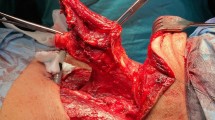Abstract
Stomal stenosis after laryngectomy has a major impact on patient rehabilitation. The major contributory factor is the operative technique. The goal is to achieve a widely patent stoma. The objective of the study was to review the long-term results of the technique of stoma creation used by the senior author (CJW). The simple technique, using skin triangles for tracheostoma creation after laryngectomy, has been used by the senior author for past 6 years. Review of 59 cases of total laryngectomy with or without partial pharyngectomies in whom this technique was used for stomaplasty. The technique described for stoma creation after total laryngectomy has been used in 59 patients (48 male, 11 female) over 6 years. The follow-up of these patients varies from 6 months to 6 years. Of these patients 54/59 (91.5%) did not have any problems with the stoma. A total of 5/59 (8.5%) patients, the stoma was narrow. Amongst these patients with narrow stoma, only 1 patient (1.7%) has had dilatation done and the others are managing reasonably with a stoma button. None of the patients in this study has required revision procedures on the stoma. The simple technique of stoma creation described in this study has good long-term results.

Similar content being viewed by others
References
Kuo M, Ho CM, Wei WI, Lam KH (1994) Tracheostomal stenosis after total laryngectomy: an analysis of predisposing clinical factors. Laryngoscope 104:59–63. doi:10.1288/00005537-199401000-00010
Wax MK, Touma BJ, Ramadan HH (1995) Tracheostomal stenosis after laryngectomy: incidence and predisposing factors. Otolaryngol Head Neck Surg 113:242–247. doi:10.1016/S0194-5998(95)70112-5
East CA, Flemming AFS, Brough MD (1988) Tracheostomal reconstruction using a fenestrated deltopectoral skin flap. J Laryngol Otol 102:282–283. doi:10.1017/S0022215100104736
Panje WR, Kitt VV (1985) Tracheal stoma reconstruction. Arch Otolaryngol 111:190–192
Clairmont AA (1978) Tracheostoma construction during laryngectomy: techniques to prevent stenosis. J Laryngol Otol 92:75–78. doi:10.1017/S0022215100084966
Lam KH, Wei WI, Wong J, Ong JB (1983) Tracheostome construction during laryngectomy: a method to prevent stenosis. Laryngoscope 93:212–215. doi:10.1288/00005537-198302000-00018
Trail ML, Chambers R, Leonard JR (1966) Z-plasty of tracheal stoma at laryngectomy. Arch Otolaryngol 88:110–112
Vlantis AC, Marres HAM, Hoogen VD, Frank JA (1998) A surgical technique to prevent tracheostomal stenosis after laryngectomy. Laryngoscope 108:134–137. doi:10.1097/00005537-199801000-00026
Griffith GR, Luce EA (1982) Tracheal stoma stenosis after laryngectomy. Plast Reconstr Surg 70:694–698. doi:10.1097/00006534-198212000-00006
Myers EN, Gallia LJ (1982) Tracheostomal stenosis following total laryngectomy. Ann Otol Rhinol Laryngol 91:450–453
Author information
Authors and Affiliations
Corresponding author
Rights and permissions
About this article
Cite this article
Bajaj, Y., Shayah, A., Loke, D. et al. Long-term results with a simple technique of stoma creation after laryngectomy. Eur Arch Otorhinolaryngol 266, 879–882 (2009). https://doi.org/10.1007/s00405-008-0805-7
Received:
Accepted:
Published:
Issue Date:
DOI: https://doi.org/10.1007/s00405-008-0805-7




